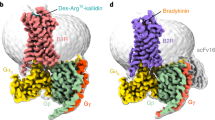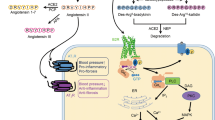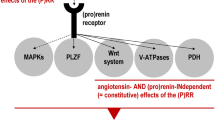Key Points
-
The kallikrein–kinin system consists of the precursor kininogens, the proteolytic kallikrein enzymes, the kinin peptides (which are produced through cleavage of kininogens by kallikreins) and two G-protein-coupled receptors (GPCRs), termed the B1 and B2 receptors, that mediate the biological effects of kinin peptides.
-
The growing knowledge of the biological role of kinins has fuelled the development of potent and selective kinin receptor modulators as potential therapeutics.
-
This medicinal chemistry effort, which was initiated with peptides in the 1970s, has now culminated in the production of a number of novel non-peptide antagonists, some of which are awaiting clinical trials.
-
This article provides an overview of the kinin biology that is relevant to the roles of kinins in disease, and then considers the potential of kinin receptor modulators in various disease indications, including inflammation and pain.
Abstract
Kinins, which are produced by the action of kallikrein enzymes, are blood-derived local-acting peptides that have broad effects mediated by two related G-protein-coupled receptors termed the bradykinin receptors. The endogenous kallikrein–kinin system controls blood circulation and kidney function, and promotes inflammation and pain in pathological conditions, which has led to interest in developing modulators of bradykinin receptors as potential therapeutics. This review discusses recent progress in our understanding of the genetics, molecular biology and pathophysiology of kinins and their receptors, as well as developments in medicinal chemistry, which have brought us closer to therapeutic applications of kinin receptor ligands in various indications. The potential of kinin receptor antagonists as novel analgesic agents that do not result in tolerance or have a liability for abuse has attracted particular interest.
This is a preview of subscription content, access via your institution
Access options
Subscribe to this journal
Receive 12 print issues and online access
$209.00 per year
only $17.42 per issue
Buy this article
- Purchase on Springer Link
- Instant access to full article PDF
Prices may be subject to local taxes which are calculated during checkout



Similar content being viewed by others
References
Blais, C. Jr, Marceau, F., Rouleau, J. L. & Adam, A. The kallikrein–kininogen–kinin system: lessons from the quantification of endogenous kinins. Peptides 21, 1903–1940 (2000).
Linz, W., Wiemer, G., Gohlke, P., Unger, T. & Shoelkens, B. A. Contribution of kinins to the cardiovascular actions of angiotensin-converting enzyme inhibitors. Pharmacol. Rev. 47, 25–49 (1995).
Gainer, J. V., Morrow, J. D., Loveland, A., King, D. J. & Brown, N. J. Effect of bradykinin-receptor blockade on the response to angiotensin-converting-enzyme inhibitor in normotensive and hypertensive subjects. N. Engl. J. Med. 339, 1285–1292 (1998).
Squire, I. B., O'Kane, K. P., Anderson, N. & Reid, J. L. Bradykinin B2 receptor antagonism attenuates blood pressure response to acute angiotensin-converting enzyme inhibition in normal men. Hypertension 36, 132–136 (2000).
Regoli, D. & Barabé, J. Pharmacology of bradykinin and related kinins. Pharmacol. Rev. 32, 1–46 (1980).
Marceau, F., Hess, J. F. & Bachvarov, D. R. The B1 receptors for kinins. Pharmacol. Rev. 50, 357–386 (1998).
McEachern, A. E. et al. Expression cloning of a rat B2 bradykinin receptor. Proc. Natl Acad. Sci. USA 88, 7724–7728 (1991).
Menke, J. G. et al. Expression cloning of a human B1 bradykinin receptor. J. Biol. Chem. 269, 21583–21586 (1994).
Borkowski, J. A. et al. Targeted disruption of a B2 bradykinin receptor gene in mice eliminates bradykinin action in smooth muscle and neurons. J. Biol. Chem. 270, 13706–13710 (1995).
Pesquero, J. B. et al. Hypoalgesia and altered inflammatory responses in mice lacking kinin B1 receptors. Proc. Natl Acad. Sci. USA 97, 8140–8145 (2000).
Alfie, M. E., Sigmon, D. H., Pomposiello, S. I. & Carretero, O. A. Effect of high salt intake in mutant mice lacking bradykinin-B2 receptors. Hypertension 29, 483–487 (1997).
Cayla, C. et al. Structure of the mammalian kinin receptor gene locus. Int. Immunopharmacol. 2, 1721–1727 (2002).
Dhamrait, S. S. et al. Variation in bradykinin receptor genes increases the cardiovascular risk associated with hypertension. Eur. Heart. J. 24, 1672–1680 (2003). A number of polymorphisms of the human kinin receptor gene locus are now known. Although much remains to be done to define haplotypes related to human disease, this article reports the largest population tested for disease predisposition predicted by SNPs or a small insertion/deletion mutations.
Dziadulewicz, E. K. et al. Nonpeptide bradykinin B2 receptor antagonists: conversion of rodent-selective bradyzide analogues into potent, orally-active human bradykinin B2 receptor antagonists. J. Med. Chem. 45, 2160–2172 (2002).
Su, D. et al. Discovery of a potent, non-peptide bradykinin B1 receptor antagonist. J. Am. Chem. Soc. 125, 7516–7517 (2003).
Gougat, J. et al. SSR240612, a new non-peptide antagonist of the bradykinin B1 receptor. Biochemical and pharmacological characterization. J. Pharmacol. Exp. Ther. 309, 661–669 (2004).
Ritchie, T. J. et al. Potent and orally bioavailable non-peptide antagonists at the human bradykinin B1 receptor based on a 2-alkylamino-5-sulfamoylbenzamide core. J. Med. Chem. 47, 4642–4644 (2004).
Emerich, D. F. et al. The development of the bradykinin agonist labradimil as a means to increase the permeability of the blood-brain barrier: from concept to clinical evaluation. Clin. Pharmacokinet. 40, 105–123 (2001).
Emanueli, C. et al. Targeting kinin B1 receptor for therapeutic neovascularization. Circulation 105, 360–366 (2002). This and previous articles support the idea that kinin receptors (mostly B 1 ) mediate inflammatory or ischaemic angiogenesis/neovascularization.
Schmaier, A. H. The physiologic basis of assembly and activation of the plasma kallikrein/kinin system. Thromb. Haemost. 91, 1–3 (2004).
Mahdi, F. et al. Mapping the interaction between high molecular weight kininogen and the urokinase plasminogen activator receptor. J. Biol. Chem. 279, 16621–16628 (2004).
Margolius, H. S. Tissue kallikreins structure, regulation, and participation in mammalian physiology and disease. Clin. Rev. Allergy Immunol. 16, 337–349 (1998).
Stadnicki, A. et al. Immunolocalization and expression of kallistatin and tissue kallikrein in human inflammatory bowel disease. Dig. Dis. Sci. 48, 615–623 (2003).
Batenburg, W. W., Garrelds, I. M., van Kats, J. P., Saxena, P. R. & Danser, A. H. Mediators of bradykinin-induced vasorelaxation in human coronary microarteries. Hypertension 43, 488–492 (2004).
Christiansen, S. C. et al. Up-regulation of functional kinin B1 receptors in allergic airway inflammation. J. Immunol. 169, 2054–2060 (2002). Reports B 1 receptor induction at work in clinically relevant material from allergic patients.
Passos, G. F. et al. Kinin B1 receptor up-regulation after lipopolysaccharide administration: role of proinflammatory cytokines and neutrophil influx. J. Immunol. 172, 1839–1847 (2004).
Souza, D. G. et al. Role of bradykinin B2 and B1 receptors in the local, remote, and systemic inflammatory responses that follow intestinal ischemia and reperfusion injury. J. Immunol. 172, 2542–2548 (2004).
Blaukat, A. et al. Overexpression and functional characterization of kinin receptors reveal subtype-specific phosphorylation. Biochemistry 38, 1300–1309 (1999).
Bachvarov, D. R. et al. Bradykinin B2 receptor endocytosis, recycling, and down-regulation assessed using green fluorescent protein conjugates. J. Pharmacol. Exp. Ther. 297, 19–26 (2001).
Sabourin, T., Bastien, L., Bachvarov, D. R. & Marceau, F. Agonist-induced translocation of the kinin B1 receptor to caveolae-related rafts. Mol. Pharmacol. 61, 546–553 (2002).
Pretorius, M., Rosenbaum, D., Vaughan, D. E. & Brown, N. J. Angiotensin-converting enzyme inhibition increases human vascular-type plasminogen activator release through endogenous bradykinin. Circulation 107, 579–585 (2003).
Molinaro, G. et al. Angiotensin-converting enzyme inhibitor-associated angioedema is characterized by a slower degradation of des-arginine9-bradykinin. J. Pharmacol. Exp. Ther. 303, 232–237 (2002).
Sulpizio, A., Pullen, M. A., Edwards, R. M. & Brooks, D. P. The effect of acute angiotensin converting enzyme (ACE) and neutral endopeptidase 24.11 (NEP) inhibition on plasma extravasation in the rat. J. Pharmacol. Exp. Ther. 309, 1141–1147 (2004).
Hornig, B., Kohler, C., Schlink, D., Tatge, H. & Drexler, H. AT1-receptor antagonism improves endothelial function in coronary artery disease by a bradykinin/B2-receptor-dependent mechanism. Hypertension 41, 1092–1095 (2003).
Katada, J. & Majima, M AT2 receptor-dependent vasodilation is mediated by activation of vascular kinin generation under flow conditions. Br. J. Pharmacol. 136, 484–491 (2002).
Aliberti, J. et al. Cutting edge: bradykinin induces IL-12 production by dendritic cells: a danger signal that drives Th1 polarization. J. Immunol. 170, 5349–5553 (2003). The effect of kinins on leukocytes is a relatively neglected topic; this study supports an immunopharmacological effect mediated by B 2 receptors.
Gobeil, F. et al. Kinin B1 receptor antagonists containing α-methyl-L-phenylalanine: in vitro and in vivo antagonistic activities. Hypertension 33, 823–829 (1999).
Neugebauer, W. et al. B1 receptor antagonists with multienzymatic resistance properties. Can. J. Physiol. Pharmacol. 80, 287–292 (2002).
Gera, L., Stewart, J. M., Whalley, E. T., Burkard, M. & Zuzack, J. S. New bradykinin antagonists having very high potency at B1 receptors. Immunopharmacology 33, 183–185 (1996).
Vavrek, R. J. & Stewart, J. M. Competitive antagonists of bradykinin. Peptides 6, 161–164 (1985).
Stewart, J. M. Bradykinin antagonists: discovery and development. Peptides 25, 527–532 (2004).
Hock, F. J. et al. Hoe 140 a new potent and long acting bradykinin-antagonist: in vitro studies. Br. J. Pharmacol. 102, 769–773 (1991). Initial pharmacological characterization of an immensely successful research reagent, presently in clinical development for hereditary angioedema and refractory ascites in liver cirrhosis.
Chan, D. et al. Bradykinin antagonist dimer, CU201, inhibits the growth of human lung cancer cell lines by a «biased agonist» mechanism. Proc. Natl Acad. Sci. USA 99, 4608–4613.
Asano, M. et al. The identification of an orally active, nonpeptide bradykinin B2 receptor antagonist, FR173657. Br. J. Pharmacol. 120, 617–624 (1997).
Pruneau, D. et al. Pharmacological profile of LF 16-0687, a new potent non-peptide bradykinin B2 receptor antagonist. Immunopharmacology 43, 187–194 (1999).
Griesbacher, T. & Legat, F. J. Effects of the non-peptide B2 receptor antagonist FR173657 in models of visceral and cutaneous inflammation. Inflamm. Res. 49, 535–540 (2000).
Uknis, A. B. et al. Bradykinin receptor antagonists type 2 attenuate the inflammatory changes in peptidoglycan-induced acute arthritis in the Lewis rat. Inflamm. Res. 50, 149–155 (2001).
Samadfam, R. et al. Contribution of B2 receptors for bradykinin in Arthus reaction-induced plasma extravasation in wild-type or B2 transgenic knockout mice. Br. J. Pharmacol. 129, 1732–1738 (2000).
Kaplanski, J. et al. LF 16-0687 Ms, a bradykinin B2 receptor antagonist, reduces brain edema and improves long-term neurological function recovery after closed head trauma in rats. J. Neurotrauma 19, 953–964 (2002).
Zausinger, S. et al. Effects of LF 16-0687 Ms, a bradykinin B2 receptor antagonist, on brain edema formation and tissue damage in a rat model of temporary focal cerebral ischemia. Brain Res. 950, 268–278 (2002).
Narotam, P. K. et al. Traumatic brain contusions: a clinical role for the kinin antagonist CP-0127. Acta Neurochir. (Wien) 140, 793–802 (1998).
Eric, J., Gabra, B. H. & Sirois, P. Implication of the bradykinin receptors in antigen-induced pulmonary inflammation in mice. Br. J. Pharmacol. 138, 1589–1597 (2003).
Burgess, G. M. et al. Bradyzide, a potent non-peptide B2 receptor antagonist with long-lasting oral activity in animal models of inflammatory hyperalgesia. Br. J. Pharmacol. 129, 77–86 (2000).
Levy, D. & Zochodne, D. W. Increased mRNA expression of the B1 and B2 bradykinin receptors and antinociceptive effects of their antagonists in an animal model of neuropathic pain. Pain 86, 265–271 (2000).
Ma, Q. P. & Heavens, R. Basal expression of bradykinin B1 receptors in the spinal cord in humans and rats. Neuroreport 12, 2311–2314 (2001).
Wotherspoon, G. & Winter, J. Bradykinin B1 rerceptor is constitutively expressed in the rat sensory nervous system. Neurosci. Lett. 294, 175–178 (2000).
Ongali, B. et al. Autoradiographic analysis of rat brain kinin B1 and B2 receptors: normal distribution and alterations induced by epilepsy. J. Comp. Neurol. 461, 506–519 (2003).
Bregola, G. et al. Changes in hippocampal and cortical B1 bradykinin receptor biological activity in two experimental models of epilepsy. Neuroscience 92, 1043–1049 (1999).
Hess, J. F. et al. Generation and characterization of a human bradykinin receptor B1 transgenic rat as a pharmacodynamic model. J. Pharmacol. Exp. Ther. 310, 488–497 (2004).
Fein, A. M. et al. Treatment of severe systemic inflammatory response syndrome and sepsis with a novel bradykinin antagonist, deltibant (CP-0127). Results of a randomized, double-blind, placebo-controlled trial. CP-0127 SIRS and Sepsis Study Group. JAMA 277, 482–487 (1997).
Gabra, B. H. & Sirois, P. Role of bradykinin B1 receptors in diabetes-induced hyperalgesia in streptozotocin-treated mice. Eur. J. Pharmacol. 457, 115–124 (2002).
Zuccollo, A. et al. The involvement of kallikrein-kinin system in diabetes type I (insulitis). Immunopharmacology 45, 69–74 (1999).
Wang, C. H. et al. Vasopeptidase inhibitor omapatrilat induces profound insulin sensitization and increases myocardial glucose uptake in Zucker fatty rats: Studies comparing a vasopeptidase inhibitor, angiotensin-converting enzyme inhibitor, and angiotensin II type I receptor blocker. Circulation 107, 1923–1929 (2003). There is a hierarchy of antihypertensive agents theoretically capable of recruiting endogenous bradykinin to improve the sensitivity to insulin: the dual peptidase inhibitor omapatrilat is the most effective, followed by an ACE inhibitor. An angiotensin type-1 receptor antagonist is inactive.
Shiuchi, T. et al. ACE inhibitor improves insulin resistance in diabetic mouse via bradykinin and NO. Hypertension 40, 329–334 (2002).
Izhar, M., Alausa, T., Folker, A., Hung, E. & Bakris, G. L. Effects of COX inhibition on blood pressure and kidney function in ACE inhibitor–treated blacks and hispanics. Hypertension 43, 573–577 (2004).
Acknowledgements
F.M.'s laboratory is supported by the Canadian Institutes for Health Research.
Author information
Authors and Affiliations
Ethics declarations
Competing interests
The authors declare no competing financial interests.
Related links
Related links
DATABASES
Entrez Gene
OMIM
Glossary
- LINKAGE DISEQUILIBRIUM
-
The association between a pair of allelic variants that occurs more often than by chance.
- CONTACT SYSTEM
-
A complex derived from four plasma proteins that is self-assembled when blood encounters a negatively charged surface.
- ZYMOGEN
-
A proenzyme. Requires enzymatic activation to exert its own effects.
- RENIN–ANGIOTENSIN SYSTEM
-
The renin–angiotensin system is a key regulator of blood pressure.
- LIPOPOLYSACCHARIDE
-
A constituent of the cell walls of Gram-negative bacteria that is thought to be important for eliciting the immune response to Gram-negative bacterial infection. Also known as endotoxin.
Rights and permissions
About this article
Cite this article
Marceau, F., Regoli, D. Bradykinin receptor ligands: therapeutic perspectives. Nat Rev Drug Discov 3, 845–852 (2004). https://doi.org/10.1038/nrd1522
Issue Date:
DOI: https://doi.org/10.1038/nrd1522
This article is cited by
-
The relationship between clinical phenotype and kallikrein-kinin bioregulation in different forms of arthritis
BMC Musculoskeletal Disorders (2023)
-
Kinin B1 and B2 receptors mediate cancer pain associated with both the tumor and oncology therapy using aromatase inhibitors
Scientific Reports (2023)
-
Cryo-EM structures of human bradykinin receptor-Gq proteins complexes
Nature Communications (2022)
-
A comprehensive review on current understanding of bradykinin in COVID-19 and inflammatory diseases
Molecular Biology Reports (2022)
-
Molecular basis for kinin selectivity and activation of the human bradykinin receptors
Nature Structural & Molecular Biology (2021)



